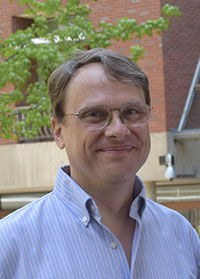
Stephen Buratowski, Ph.D.
Our lab studies eukaryotic gene expression. We are concentrating on three areas: (A) the functions and interactions of the RNA polymerase II (RNApII) basal transcription factors, (B) the communication between chromatin and the transcription machinery, and (C) mRNA processing enzymes and their interactions with RNApII.
Research:
Our lab studies eukaryotic gene expression. We are concentrating on three areas: (A) the functions and interactions of the RNA polymerase II (RNApII) basal transcription factors, (B) the communication between chromatin and the transcription machinery, and (C) mRNA processing enzymes and their interactions with RNApII. Using the yeast Saccharomyces cerevisiae, a combination of biochemical and genetic techniques are being brought to bear on these questions. Several dozen proteins are required simply to initiate transcription, and many more are required for processes linked to transcription. Therefore, it is now necessary to decipher the functions of each of the individual factors. Some of our recent projects:
1. The RNApII C-terminal domain (CTD) and mRNA processing enzymes. mRNAs are capped at the 5' end and polyadenylated at the 3' ends. We discovered that the phosphorylated CTD acts as a binding site for mRNA processing enzymes, thereby linking transcription and mRNA processing. Interestingly, the pattern of CTD phosphorylation changes at various points of transcription initiation and elongation. It appears that these different phosphorylated forms bind different sets of factors involved in regulation of elongation, termination, capping, splicing, and polyadenylation.
2. We are studying the many factors that modulate transcription elongation and termination by RNApII. We have found that different mechanisms are used for termination at different classes of genes. Genes that encode polyadenylated mRNAs use an exonuclease-dependent pathway, while genes for the non-polyadenylated sn/snoRNAs use a pathway that includes the exosome and the Nrd1 and Nab3 RNA binding proteins. We are working to further understand the two pathways and how the choice is made between them.
3. Connections between transcription and chromatin structure. We and others showed that the act of transcription causes major changes in the nucleosomes that package the gene. For example, the histone methyltransferases Set1 and Set2 are targeted to promoter and coding regions, respectively, via binding to the phosphorylated RNApII CTD. Specific demethylases also regulate gene regulation. These transcription-coupled histone methylation patterns have been linked to human cancers, but yeast provides a perfect model system for getting at their basic functions.
Address:
Room C-347
240 Longwood Avenue
Boston, MA 02115
Elife
View full abstract on Pubmed
Nat Commun
View full abstract on Pubmed
Mol Cell
View full abstract on Pubmed
Genes Dev
View full abstract on Pubmed
Cell Rep
View full abstract on Pubmed
Exp Mol Med
View full abstract on Pubmed
Nat Commun
View full abstract on Pubmed
Mol Cell
View full abstract on Pubmed
Cell
View full abstract on Pubmed